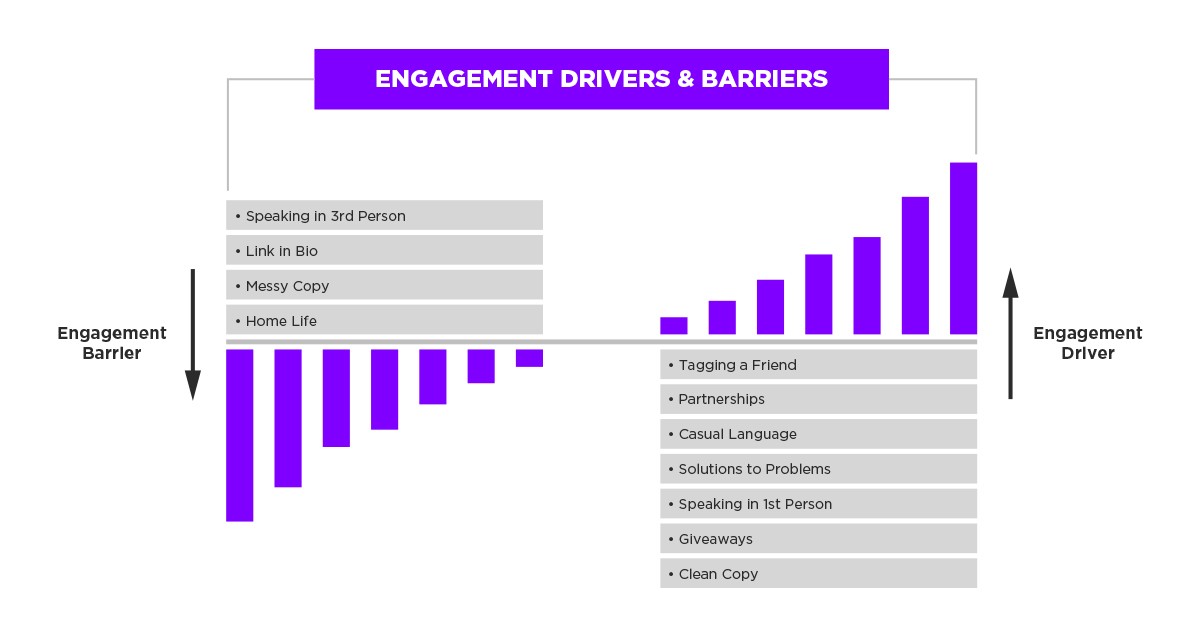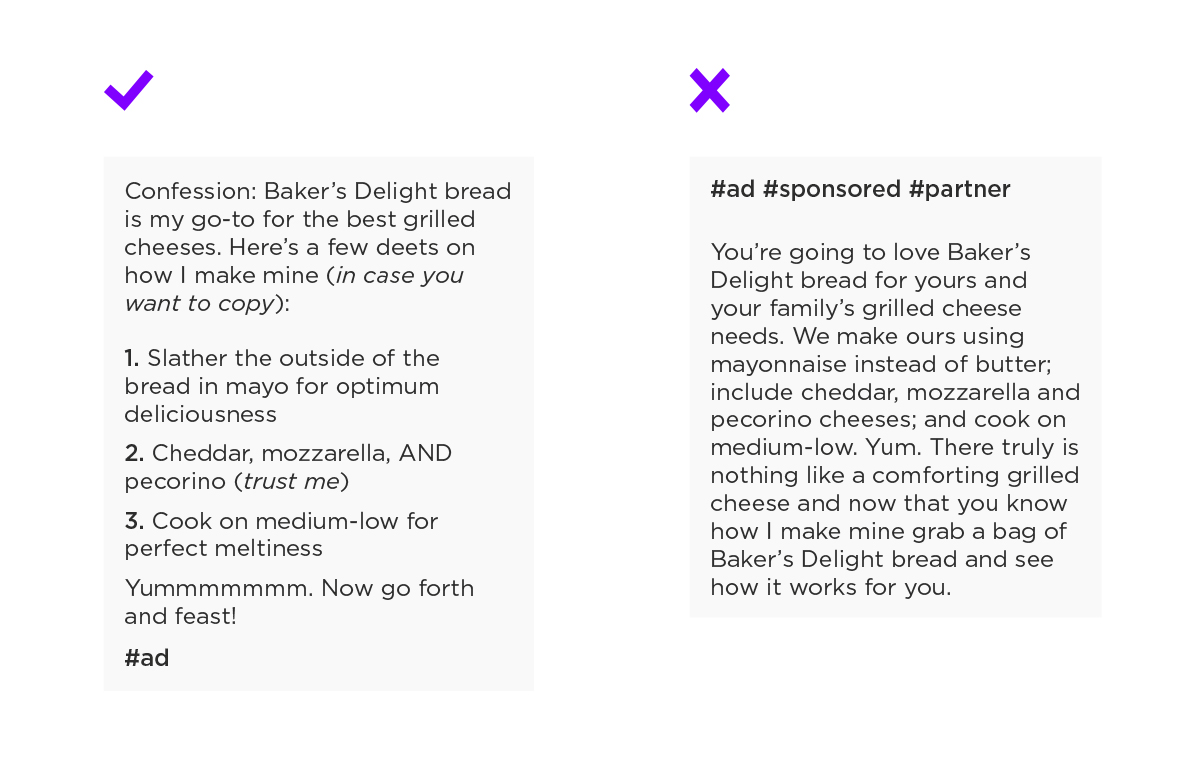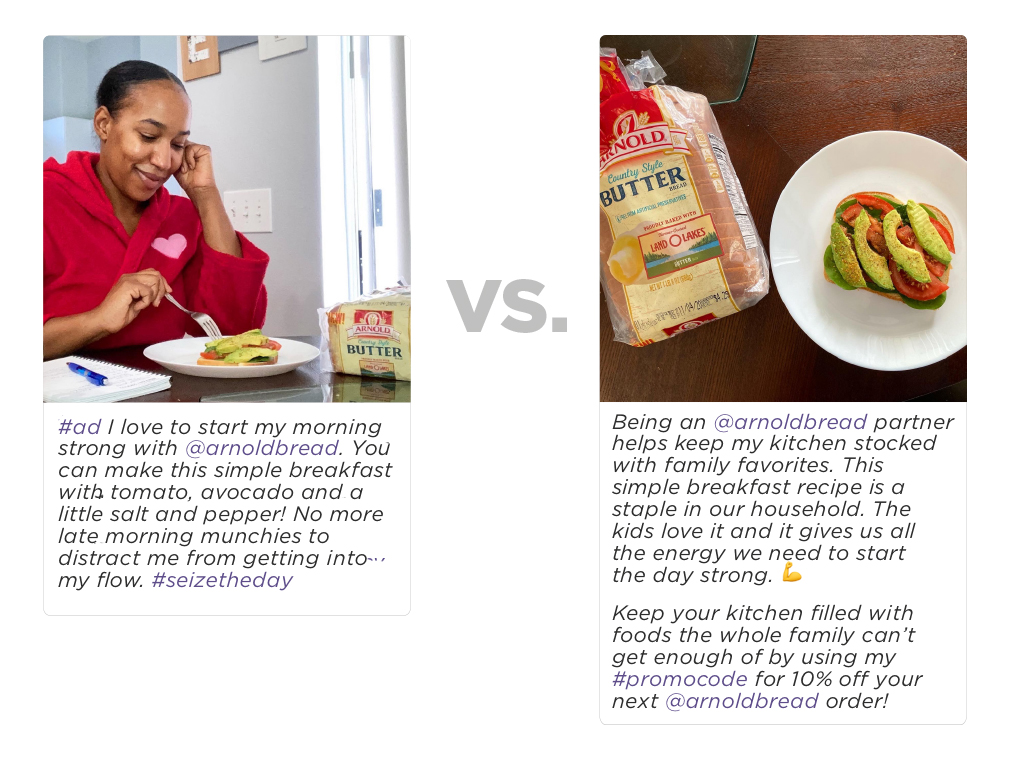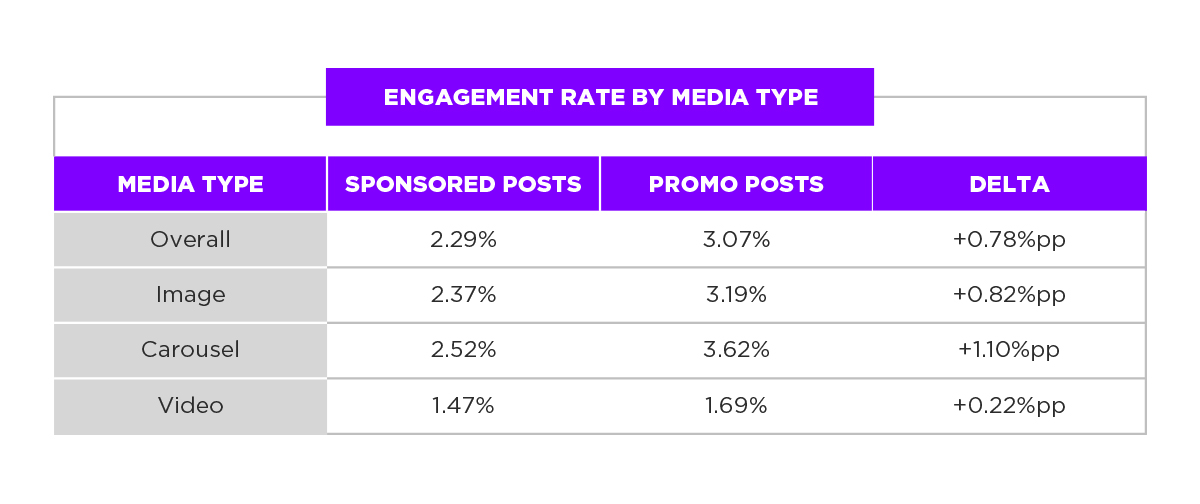The Ultimate Guide to Influencer Partnerships

We’ve all had that moment of staring at a blank white box where social post copy should go. It can be hard to think of creative words that also get your message across day in and day out. This challenge is heightened for brands and agencies working on influencer partnerships. You want the influencer’s aesthetic and the brand’s messaging to be communicated clearly and effectively, but how will that really impact the success of the campaign?
The game of influencer marketing can be hard to beat. With so much noise and competition on social media, brands and influencers need to do everything they can to get that extra advantage in the feed. And as these partnerships become a bigger part of marketing budgets, there’s more data out there that gives us insight into what’s working, and what isn’t.
This post is the culmination of a collaborative study between top marketing researchers and 1000heads, a leader in social-first digital marketing. We set out to understand how even the smallest tweak in copy could impact brand and influencer partnership content and what best practices could be instituted to ensure optimized performance for partnership campaigns.
These insights will help any brand marketer elevate their influencer partnerships to ensure they hit performance objectives and provide a best-in-class experience for consumers.
METHODOLOGY: Leveraging the industry standard.
The 1000heads Insights team collaborated with a committee of faculty, data scientists and researchers at NYU, Dartmouth, USC and Tulane to analyze over 12,000 influencer and brand partner posts on Instagram. Social posts were leveraged from 1000heads’ proprietary influencer tracking platform VOICEBox and cover content from several thousand influencers across a diverse range of influencer passions and industry sectors. The analysis focused on the impact of linguistic features on influencer post engagement (likes, comments and shares).
The researchers leveraged the industry-standard dictionary for text analysis, LIWC (Linguistic Inquiry Word Count), to build a machine learning regression model to determine which linguistic qualities of an Instagram post help and hurt engagement rates (ratio of engagements to influencer follower size). 1000heads added a layer of analysis, drawing out practical insights on how brands and influencers can collaborate to create more effective social media content.
AUTHENTICITY: Genuine connections between brands, influencers and followers breed trust.
The better social media ads get at reading our minds, the less we trust brands on social platforms, and the more likely we are to take a recommendation from trusted influencers who share their own experience. Consumers crave authenticity online.
Our research found that the format of posts may influence how the content is received by consumers. When your brand is working with influencer partners to create content, you can use these simple insights to create post copy that really resonates with the influencer’s audience.
“Followers want influencer content to feel authentic and real, like a conversation with a friend. Content that feels unnatural or too sales heavy is likely to lose the interest of followers.”
First, posts containing casual language (slang, abbreviations) and auxiliary verbs (forms of “be,” “do,” and “have”) performed better than those that didn’t. This implies that followers want influencer content to feel authentic and real, like a conversation with a friend. Content that feels unnatural or too sales heavy is likely to lose the interest of followers.
Our research also showed the importance of utility when it comes to speaking to consumers. More specifically, posts that used “help,” “protect,” or “stop” saw higher engagement rates, a 9.7% increase. Such language is able to trigger that the post will offer value to the audience and help make their lives easier or better in some way.
Second, people follow influencers because they care about what that person thinks and feels. When influencers use first-person language (“I,” “me,” “my”) followers are more likely to engage; we saw a +3%pp increase in engagement rate. Talking about what they’re doing or why they love a product can drive engagement up, and the converse is also true.
When influencers talk too much about others, using pronouns like “she,” “he,” and “they,” the engagement on that post goes down. This includes talking about the followers themselves. Our research found that while addressing followers with “you” and “your” is generally okay, overuse, especially in the context of a sponsored post, can come off less sincere and too forceful.

READABILITY: Looking beyond the picture — post copy can impact campaign performance.
Although visuals are the best way to get the attention of users, captions are becoming increasingly more important. The movement toward “microblogging” — a long-form social media post that goes into additional detail or tells a story related to the post — signifies that a pretty picture isn’t the only way to stop people from scrolling.
However, our research uncovered that users don’t just want content, but want it formatted in an easily digestible way. Proper formatting in a post resulted in +6%pp better engagement performance on that piece of content.
When creating body copy for a post, it’s important to keep readability in mind. Formatting posts with organized lists and colons (:) draw the reader’s eye through the text and guide them to the most important pieces of information. Additionally, using numbers to list out items or steps in a process appeals to audiences.
Conversely, our research found that lists in paragraphs with an excess of commas take more effort to read and as a result lose followers’ attention.

Remember when creating body copy that readability is an important factor in capturing and keeping consumers’ attention.
IMPACT OF DISCLOSURES: How to set the ground rules for your influencer partnerships.
The proliferation of influencers was fast — faster than the Federal Trade Commission (FTC) could keep up with in terms of regulation and guidelines. While broad guidelines were introduced in late 2017, it wasn’t until late 2019 that the FTC more clearly defined disclosures and sponsorships and started very publicly enforcing compliance with their influencer guidelines.
With the importance of disclosures and FTC compliance in mind, we looked at how copy-based disclosures impacted influencer content, specifically the volume of disclosures as well as the location of the disclosures within the posts’ copy.
“When working with an influencer, brands should be prescriptive in how they want influencers to disclose the relationship.”
The FTC requires sponsored posts to use simple and clear language to disclose the relationship between brand and influencer. Simple explanations like, “Thanks to Arnold Bread for the free product,” can be enough if placed at the top of the post in a way that is hard to miss.
In terms of disclosure location, the FTC requires some kind of disclosure in the first few words of the post. Terms that describe the influencer as a “partner” or “ambassador” for the brand are acceptable.
Including hashtags with disclosures such as “ad,” “advertisement,” and “sponsored” are not necessary. In fact, our research found that those hashtags at the end of the copy led to slightly higher engagement (+0.2% percentage points) compared to posts where influencers led with the disclosure hashtag. Although the difference was small, when looking at engagement rates between 3% to 4% (the average for influencer and brand partner content) even the smallest increase in engagement rate can have an impact on the post’s overall performance.
While disclosing influencer and brand relationships at the beginning of the post is important, do it in a clear and natural way that describes the relationship and save those hashtags for the end of the post.
When working with an influencer, brands should be prescriptive in how they want influencers to disclose the relationship — not just leave it up to the influencer. This protects the brand as well as the performance potential of the post.
Additionally, when an influencer indicates they are “partnering” with a brand, the content lends itself to be received as authentic and genuine. This verbiage indicates the brand and influencer have an authentic relationship and chips away at the perception that influencers are just mouthpieces for brands in disguise. A partnership assumes a level of autonomy for the influencer, which in turn makes the relationship less transactional.
PARTNERSHIP POST TYPES: Determining the right type of post for your campaign.
One of the biggest areas of discussion is how branded influencer content is executed. While there is a seemingly endless variety of combinations in which content can come to life, researchers on this project found two major post types that influencer and brand partnership content fell into. It’s important to note that these definitions are not the industry standard, but are the result of this research project. These post types are:
- Sponsored Content: Influencer content with the primary goal of generating awareness for a particular product or brand (with no direct call-to-action or CTA).
- Promotional Content: The key distinction between sponsored content and promotional content (promo) is that promotional posts usually include a benefit or incentive for the influencer’s audience. This usually takes the form of a direct CTA in the copy of the post, for example, entering a giveaway or using a custom discount code.

We categorized over twelve thousand posts into these two categories and found statistically significant differences in engagement performance, specifically looking at engagement rate (ratio of engagements to influencer follower size). Promotional content saw a stronger engagement rate overall compared to sponsored content; this trend held true when the data was broken down by media type:

“Brands and agencies should think about how they can incentivize the influencer’s audience to take an action, whether that be to follow the brand, click a link, or make a purchase.”
No exceptions to this trend across media types simplify the takeaway: promotional posts consistently drive stronger engagement from audiences than sponsored posts, roughly 34% higher. This means brands and agencies looking to strike content deals with influencers should think about how they can incentivize the influencer’s audience to take an action, whether that be to follow the brand, click a link, or make a purchase.
Depending on the campaign objectives, however, sponsored content can still be effective, especially when looking at top of the funnel drivers (awareness and consideration). Promotional content, while also generating awareness, is inherently tied to the lower half of the funnel as its use of a CTA drives audiences toward converting into a sale, redemption, subscription or any other action or engagement.
It’s also important to note that incentivized engagement can result in lower quality engagement. Although this research project showed that promotions like giveaways increase engagement rates, industry best practices recommend a conservative and strategic use of this post type. Brands interested in building out a robust influencer marketing strategy should consider working with a consultative agency to ensure their influencer partnership campaigns match the goals of the organization.
Digging a little deeper into the data, we looked at the impact of copy on engagement across both sponsored and promo content. A very familiar term in the world of social media stood out: “Link in bio”. This term was used frequently as it appeared in 11% of sponsored posts and 15% of promo posts that were analyzed. While the term’s usage was associated with lower levels of engagement overall, we found its use to be more effective with promotional posts compared to sponsored posts, in alignment with the finding that promo content consistently performs better than sponsored content in regard to engagement rates.
“A very familiar term in the world of social media stood out: ‘Link in bio’. This terms was used frequently as it appeared in 11% of sponsored posts and 15% of promo posts that were analysed.”
Further, although engagement rates are consistently lower when “Link in bio” is in the post copy, that does not necessarily mean the post is ineffective. Because engagement rate in our model is calculated as likes, shares and comments, link clicks would not be considered “engagement.” Engagement rates could be lower because “Link in bio” encourages users to stop engaging with the post and move over to the influencer’s bio page to continue engagement. A robust influencer marketing strategy should take this action into consideration and not disregard “Link in bio” as a tool if their marketing objectives align with the consumer action.
In short, fewer consumers taking more significant action, like clicking to a brand’s website, could be a better result than higher engagement on a single post.
BRAND TAKEAWAYS HIT LIST: Putting this research into practice.
- Consumers are more likely to engage with content that feels casual and authentic, not like a sales pitch.
- Influencer partners should be encouraged to speak about their own experience with the product or service, using language like “I,” “me,” and “my” in their posts.
- Create readability guidelines for influencer partners that encourage bulleted lists and numbers that outline steps or actions. This has been shown to improve engagement rates with the content.
- When it comes to disclosing an influencer and brand relationship, less is more. Ensure your copy meets the FTC requirements without over-using sales and advertising language.
- Include important details like the relationship disclosure, product information or giveaway instructions at the top of the post and reiterate disclosures using hashtags at the bottom of the post.
- Think of influencers as partners, not just another advertising channel. Your content should reflect an equitable and collaborative relationship.
- Promotional content that incentivizes consumers to take an action always results in higher engagement rates.
- Including a “Link in bio” that drives users away from the post can lower engagement, but may result in more qualified consumers taking more significant action, like a website click.
- The choice between sponsored and promotional content, and including a “Link in bio” copy, depends on your marketing objectives. Identify whether awareness or conversion is more important to your campaign before working with an influencer.
CLOSING REMARKS
Overall, every influencer partnership is different, but the learnings we’ve found help to ensure optimal performance through best practices. Brand and influencer partnerships don’t need to be left in the hands of chance or instinct; there can be a method to the madness. Influencer content can be strategically planned when practical insights are integrated into the process. The best brand marketers will take these insights and apply them to every campaign to ensure success in influencer marketing.
If you’d like to learn more about how influencer partnerships can build advocacy for your brand, drop us a line at info@1000heads.com ?.
This post was written by: Majed Alnahwi, Raheal Aragawi, Andrew Bose and Savannah Hobbs
Research by: Jared Watson, Lauren Grewal, Shoshana Segal, Kalinda Ukanwa, Ted Matherly, Andrew Bose, Deanna Sandmann and Majed Alnahwi
ABOUT NYU MARKETING DEPARTMENT:
Jared Watson is an assistant professor of marketing at NYU whose interests include information diagnosticity and social influence in online environments. Lauren Grewal is an assistant professor of marketing at Dartmouth College whose interests include social influence and identity relevance in the marketplace. Shoshana Segalis a PhD student at NYU whose interests span from the role of social media in marketing to the role of marketing in healthcare decisions. Kalinda Ukanwa is an assistant professor of marketing at USC whose interests include reputation dynamics and algorithmic bias. And last, but certainly not least, Ted Matherly is a visiting assistant professor of marketing at Tulane whose interest is in applying big data to providing insights into everyday consumer behaviors.